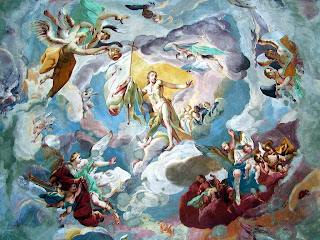
Title: Christ in the Wilderness Surrounded by Angels
Artist: Charles de La Fosse
Medium: Oil on Canvas
Size: 143 x 193 cm
Date: c. 1690
Location: Hermitage,
Matthew 4:11: Then the devil leaves him, and behold, angels came and ministered to him.
Christ was succored after the temptation, God's agents providing for Jesus' as soon as he has vanquished his foe. After three high-stake tests the devil is driven away, and therefore Jesus can later state, in Matthew 12:29, “How can anyone go into a strong man’s house and steal his property? First he must tie up the strong man. Then he can go through his house and steal his property.” Jesus can say that he is freeing Satan's possessions because he has already bound the strong man. Jesus is the new Moses who will provide bread for his people, whom God will deliver by the resurrection, and who will eventually rule the nations.
This painting shows Jesus on the verge of ecstasy, his face a mixture of triumph and exhaustion. Having put his trust in the Lord he waits, as down, through a celestial light, the angles descend towards him, gather at his feet, bring trays of nourishment. The light from above is golden and cascades like a spotlight across the angels and onto Jesus. But unlike the angels, whose only illumination is from God’s light, Jesus is depicted with a faint nimbus, a sign that he, too, is Holy.
Charles de La Fosse (1636, Paris - 1716,












